![]()
![]()
![]()
Use LEFT and RIGHT arrow keys to navigate between flashcards;
Use UP and DOWN arrow keys to flip the card;
H to show hint;
A reads text to speech;
88 Cards in this Set
- Front
- Back
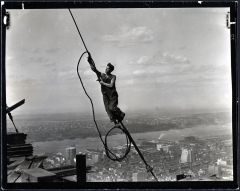
|
Lewis Hine - Icarus - 1931
From Men at Work |
|
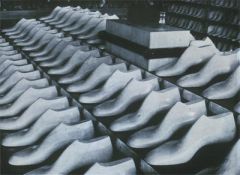
|
Albert Renger-Patzsch - Shoe Forms - 1928
In collection: World is beautiful -looking for symmetry, generic, machine aesthetic - already beautiful, no need to make more beautiful (everyday is beautiful) - book attempted to show "thingness" - standardize / regularize objects (attacked for being just photo form of painting) constructivism |
|
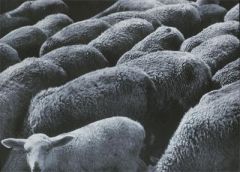
|
Albert Renger-Patzsch - Sheep - 1928
In World is Beautiful -looking for parallels with shoe forms, constructivism |
|
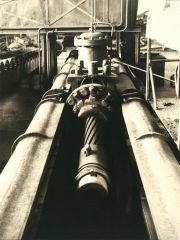
|
Albert Renger-Patzsch - Untitled - 1928
In World is Beautiful - machine aesthetic, showing beauty in simplicity/industrial constructivism |
|
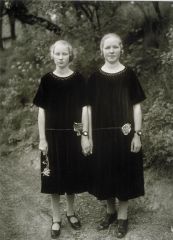
|
August Sander - Peasant Girls - 1911-1945
in Citizens of the Twentieth Century - visual document of German citizens at the time, carefully staged, clean portraits of people he thought were good examples of their socioeconomic status/activity - formal portraits, eye level, full body, characteristic poses |
|
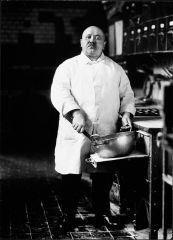
|
August Sander - Konditor - 1911-1945
- everyone treated with an egalitarian look characteristic of documentary - creates huge spectrum of socioeconomic classes |
|
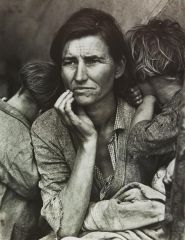
|
Dorothea Lange - Migrant Mother - 1936
|
|
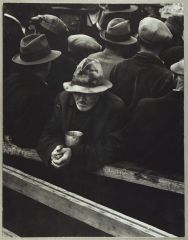
|
Dorothea Lange - Bread Line - 1936
|
|
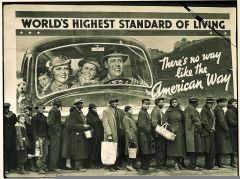
|
Margaret Bourke-White - At the Time of the Louisville Flood - 1937
- Unintentionally showed contrast between the ideal American Way (white people) and those in need of aid for flood (blacks) - not really class conflict because they are all middle-class, ONLY shows race conflict |
|
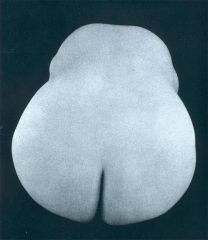
|
Edward Weston - Nude - 1925
- comparing human forms, body like fruit, comparing human to objects |
|
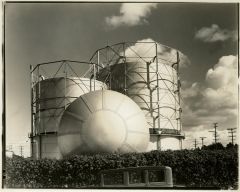
|
Imogen Cunningham - Gas Tanks - 1937
- being transformed by photography to something special - transforming contemporary hardware to futuristic - streamline aesthetic - like Renger-Patzsch |
|
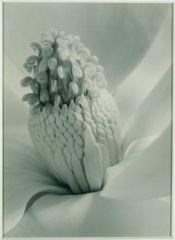
|
Imogen Cunnigham - Tower of Jewels - 1925
- clear but subtle transition of light and dark - good tones - art, not science - close up / portrait like style |
|

|
Ansel Adams - Mount Williamson - 1944
- clear, full depth of field (typical of f64 group) - spent a lot of time in nature |
|
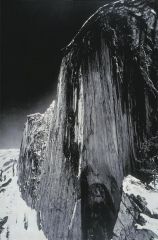
|
Ansel Adams - Monolith: The Face of Half-Dome, Yosemite - 1927
- retraces historical photographic steps of Yosemite |
|
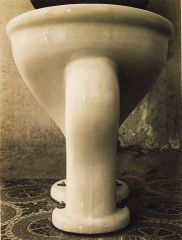
|
Edward Weston - Excusado - 1925
f64 GROUP- smallest possible aperture (greatest depth of field) - more aestheticized art as opposed to traditional view of toilet - emphasized previsualization (imagining photo before taken - compare tones of life to tones in chart, imagine final product) - sensual in light, texture of nature - close up sharply detailed everyday objects typical in his work |
|
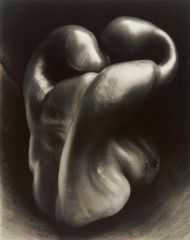
|
Edward Weston - Pepper - 1930
- Long exposure, small aperture - Sense of gestures, takes on qualities of a body COMPARING FRUITS & BODIES (humanizing pepper - comparing two, saying can look like each other) |
|
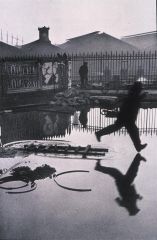
|
Henri Cartier-Bresson - Place de l'Europe -1932
- decisive moment (photographic moment) = new definition of photography as technical abilities important; simultaneous recognition - what content renders taking a pic + when to take pic (hit shutter) = inseparable in form of photo |
|
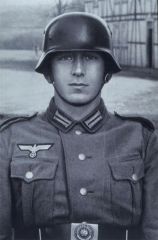
|
August Sander - Young Soldier - 1911-1945
in Citizens of Twentieth Century |
|
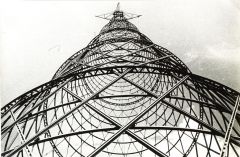
|
Alexander Rodchenko - Schuchov Transmission Tower - 1929
- machine aesthetic, bring to machinelike world of communism - making expected appearances strange - obstructing regular habits of seeing |
|

|
Rodchenko - Pioneer - 1930
- camera = material objective new way of seeing - like communism new reconstruction of reality - constructed camera vision as own vision (connects socialism) - anonymous + heroicized |
|
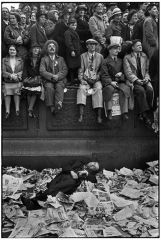
|
Cartier-Bresson - The Coronation of King George VI - 1937
- photographer there at the time feeling way around reality visually - photographer as totally mobile (in the action) - decisive moment - displays instinct and notion of being present |
|

|
Brassai - Lesbian Couple at Le Monocle - 1932
- document in history of alternative sexuality, and various subcultures - documenting what he sees, no neutral construction of a photograph |
|

|
Eugene Atget - Heurtoir (Door Knocker) - 1901-02
- Pictures of architecture, make a visual record just for own sake, not looking for anything - looking AT everything, documentary impulse - Huge body of work, sold photos to anyone for anything - Not art, purely documentary - surrealists really like him, didn't care |
|
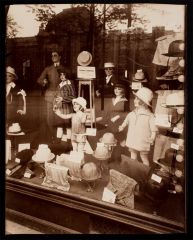
|
Eugene Atget - Avenue des Gobelins - 1925
-Play between scene of shop window & and reflection as if two are together - mannequins are on street (documentary accident) |
|
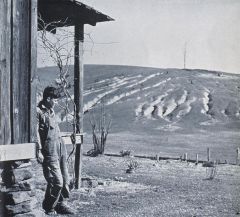
|
Arthur Rothstein - Eroded Land on an Alabama Farm - 1937
- made to tell story without need for information - FSA commissioned photos |
|
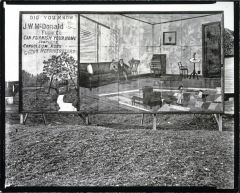
|
Walker Evans - Houses and Billboards, Atlanta - 1936
|
|

|
Walker Evans - Penny Picture Display - 1936
- photo of a display window - worked with the FSA to document not human drama but pictures of everyday material - photographing photography, showing how the people in the portraits think they're special - showing they're NOT (just part of millions of anonymous standard photos) - pic cut to make it look like the pix are endless |
|
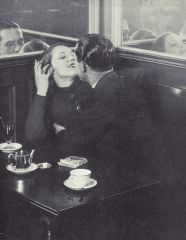
|
Brassai - Lovers, Place d'Italie - 1932
- Iconic image of Parisian PDA - mediating public & private lives |
|

|
WeeGee - WeeGee's Office - 1942
- office in back of his car, NEWS PHOTOGRAPHER - shows photographers mobility - WeeGee showed how news photography provided means to pull people into places they'll never be |
|
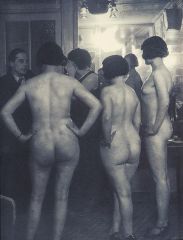
|
Brassai - Chez Suzy: Introductions - 1932
- brothel - man is unconcerned with being identified - documentary never simply recording - photographer always has knowledge of what he wants to show (lighting, pose, anonymity, yet identification all create a record) - no neutral construction of a photo --> makes whats in the photo speak about something |
|
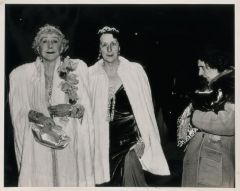
|
Weegee - The Critic - 1943
!??!? ?!!?!?!?!?!? |
|
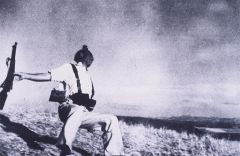
|
Robert Capa - Death of a Loyalist Soldier - 1936
- war in photography journalism - idea of photographer as totally mobile (in the action, in the danger zone) - photo of a Loyalist soldier during the Mexican Civil War, controversy behind if staged/real - heroicizing soldier bc lot of negative space and he's the only thing in it |
|

|
Harold Edgerton - Hydrogen Bomb Blasts - early 1950s
- part of study of bomb; took 8-11 miles from blast - electronically triggered polarized shutters, new level of sublime - cold war period - unique - pix nobody else can take |
|
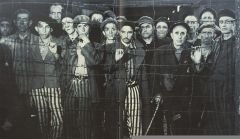
|
Margaret Bourke-White - The Living Dead, Buchenwald - 1945
- liberation - photography made visible the capacity for inhumanity at end of WWII |
|
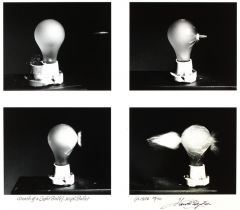
|
Edgerton - Death of a Lightbulb - 1936
- new cool things nobody would have thought of photographing - fractures time down to see different moments/stages - like new Muybridge |
|
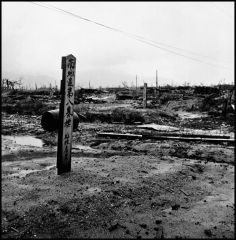
|
Wayne Miller - Hiroshima - 1945
- epicenter of the atomic blast - pix taken for the US Navy - photography exposing inhumanities of the time |
|
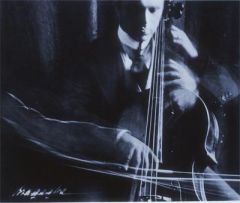
|
Anton Giullio Bragaglia - The Cellist - 1913
- Not cleaned up like Mulbridge - tracking motion of his fingers (long exposure time) - Italian dynamic Futurism embrace mistakes / random unevenness - humans need to mechanize themselves, embrace universalness |
|
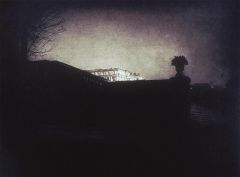
|
Edward Steichen - Nocturne: Orangerie Staircase, Versailles - 1907
- looks like graphic art - uncertain about scale/space - looks like charcoal drawing |
|

|
Alfred Stieglitz - The Steerage - 1907
- relations between forms letting all details happen, pretending subject not so important (getting everything in picture, opposed to just focusing on one person) - comparison style working both pictoralist AND straight photography |
|
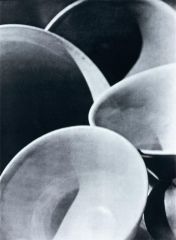
|
Paul Strand - Abstraction: Bowls - 1915
- embraces photographic forms of modern art - cubism = b/c we have cameras, art shouldn't document but instead be essential sense of 3D perspective - strand as new takeover on art photography |
|
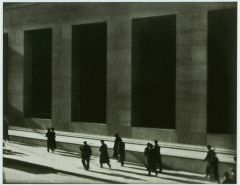
|
Paul Strand - Wall Street - 1915
- engagement with experience, trappings of modern life + finding photographic view/part scale of experience of NY - photographic clarity between modern/traditional - simple/strong geometric shape |
|
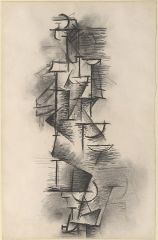
|
Picasso - Nude - 1910
- 1900 = high point of analytical cubism - sharp lines + dark/light contrast = feeling of dynamic space - supposed to look like a nude lady - published in Stieglitz's Camera Work in 1912 |
|
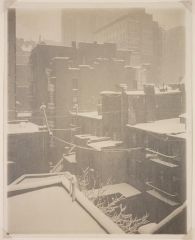
|
Stieglitz - View from Window of "291" - 1915
- rise of cubism, snow against dark features - geometric in buildings (view from studio) |
|

|
Alvin Langdon Coburn - Vortograph - 1917
- dynamic, embrace ideas like reflection + doubling, using form to convey jittery - interested in the lines - vorticism pics shot with mirrors/reflective surfaces, adapt non objective vocab -> modern vision as fragmented |
|

|
Edward Steichen - Douglass Lighters - 1928
- photo for ad, borrowing vocab from modern art - brings ideas from modernism to popular first gen of art photographs (through ads, etc) |
|

|
Alfred Stieglitz - Equivalent - 1920s
- pictures goal to use pure form to communicate some sensation on spiritual level BOOK |
|
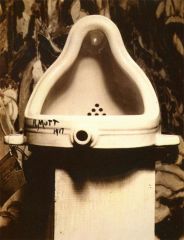
|
Alfred Stieglitz - Fountain - 1917
Marcel Duchamp - NYC exhibition said open to any form of artistic expression, so he sent a urinal signed with a fake name and it was refused - origin of Dada challenging peoples artistic ideas - expression should be completely free -> he chose this and created a new thought/context for it - Stieglitz photographed like Strand because photo'd subject and changed its context -> AGAINST single authorship - opened up what could be considered art - ready-mades = everyday objects put in new contexts |
|
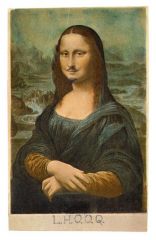
|
Marcel Duchamps - L.H.O.O.Q - 1919
- taking a ready made thing and recontextualizing - "she has a hot ass" - direct challenge to high culture - conceptual anti-art - taking something touristic and making NOT -> also gender-bending |
|
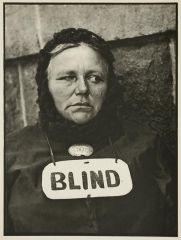
|
Paul Strand - Blind Woman - 1917
- we see her, she does not (no possibility of emotional diologue) - reoccurring issue with street photography for subjects to = victims - document of urban life in NY in the teens - exploits/ part of urban life but not just observing buildings, get close & see deformities - neutral observing camera makes voyeuristic spectacle, photo prevents us from empathizing -> we see, she doesn't (no diologue) - exploiting photos - subjects as victims PUBLISHED AS ART |
|
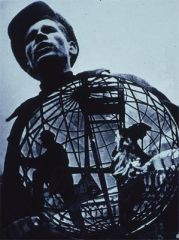
|
El Lissitzky - Socialist Construction (Dresden) - 1929
- modern=propaganda - objective form of usual expression not critique but as parallel to construction of new reality |
|
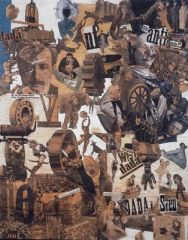
|
Hannah Hoch - Cut With the Kitchen Knife Dada Through the Last Weimar Beer-Belly Cultural Epoch of Germany - 1929
- dada = embrace of the irrational - Euro dada political + meant as form of attacks on bourgeoisie - "screw your isms" |
|

|
Man Ray - Solarization - 1929
- solarization: turning on light quickly during developing process, gives glow to subject - reversal of tones ( & unpredictable edge) |
|

|
Hans Bellmer - The Doll - 1936
- weird fantasy of possessing female body - surreal forbidden sensuality |
|
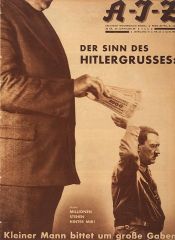
|
John Heartfield - The Meaning of the "Heil Hitler" Salute - 1932
- photomontage - Cover of AIZ - loyalty to Hitler+getting bribes; playing with scale - little man asks for big gifts - Hitler supported by big business "millions behind me" (both millions of supporters, and millions of DOLLARS) - cultural voyeurism |
|
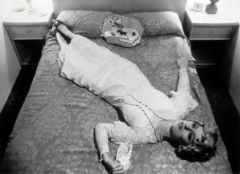
|
Cindy Sherman - Untitled Film Stills - 1978-79
- model in fake film stills, showed conventions from cinema culture by this time nostalgic - (restaged, to look like movie, as cinemas used film stills at ticket window in old times) - film still = artificial versions about things already artificial, by making fake film stills = 3x artificial - All depicting cliches, self portrait but not expressing herself, only conventions of cinematic narrative and feminity - POSTMODERN COPY - continuation of feminist art and feminist movement - beautiful in both meaning and composition |
|
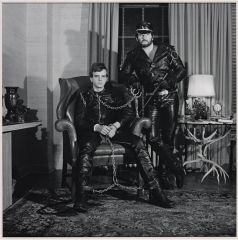
|
Robert Mapplethorpe - Brian Ridley and Lyle Heeter - 1979
- identity through subcultures - following Arbus's nude retired couple in really sexualized, kinkee subculture, yet within middle class living room context - bringing subculture to the living room - weird composition with normal looking high art moose antler table yet also intense queer subculture |
|
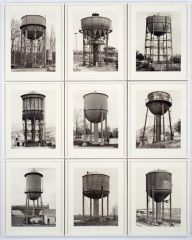
|
Bernd and Hilla Becher - Water Towers - 1980
shows: 1) german tradition of machine aesthetic 2) neutral documentary modes: portraits like Sander, creating archives -fluidity of photo documents-> see aesthetic of architecture, but also their aesthetic nature - uniformity in architecture + how they photographed it (all taken at same height and angle (same way) -> proving way to look at these in an artistic form) |
|

|
Laurie Simmons - Interiors: Pushing Lipstick #1 - 1978
- artificial conditions of femininity, total embrace of artificiality |
|
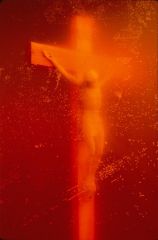
|
Andres Serrano - Piss Christ - 1987
- plastic cross emerged in bucket of artist's pee - meant respectfully, showing how Christ was "****** on", and everything created by God is sacred, even pee - controversial piece, not many people understood it - only a few made |
|
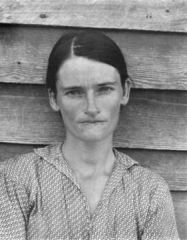
|
Sheri Levine - After Walker Evans - 1981
- photograph of Walker Evans's photograph "Allie Mae Burroughs" - directly challenging authorship and authenticity - with so many reproductions, lose value / differentiation of the original - whats to stop her from reproducing the icon-> iconicized movement (starting notion of iconic art photography & prominent artists would understand this picture) - photo gives option to feel neutral - what is the REAL photo?! |
|
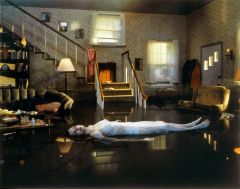
|
Gregory Crewdson - Untitled (Ophelia) - 2001
- sort of like film stills->definitely cinematic and carefully set up - representing artificiality - shows the deliberately constructed (therefore an emotionless production) - plays with traditional Shakespearean in a modern era/context (title) |
|
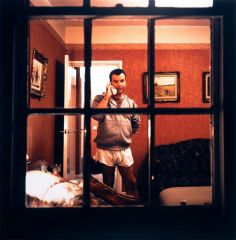
|
Shizuka Yokonizo - The Stranger Series - 1998-2000
(Stranger #1) - surveillance & observation - shows how light works in a room, transforms their own potential private spaces/rooms to illuminated rooms - play on old room-sized camera obscuras --> whereas used to be dark inside the room looking to the outside, now dark outside the room looking into an illuminated room |
|
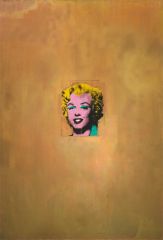
|
Andy Warhol - Gold Marilyn - 1962
- pop art stopped from being high art culture to more accessible to the masses -> mirrored the common pop culture - deployment into higher context, was trying to be a mirror of (then-/ current culture |
|
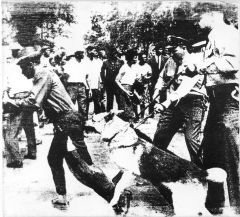
|
Andy Warhol - Race Riot - 1964
- thinking about art as media - photojournalism was a big part of showing struggle - silk screen a fragment of media landscape -> neutral view/image on serious social issue - by being pop art, provocative in stating that civil rights is just whatevers in the news (neutral on SERIOUS topic) (reflection of contemporary) |
|
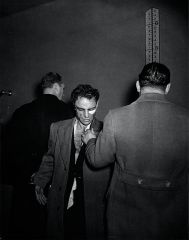
|
WeeGee - Booked on Suspicion of Killing a Policeman - 1939
- WeeGee's style as content is about news / murder - uses big flash, rule of threes in that theres 3 people |
|
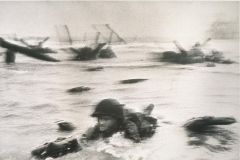
|
Robert Capa - D-Day, Omaha Beach, Normandy - 1944
- okay with it being blurry because it's war and thats what war is - typical of Capa being "in the action" |
|
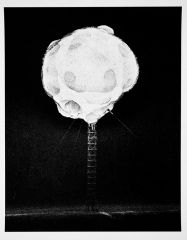
|
Harold Edgerton ??????????????????????????????????????
|
|
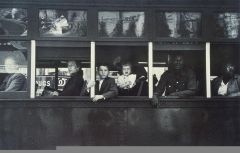
|
Robert Frank - New Orleans - 1958
- Part of The Americans - snapshot photo aesthetic - photo'd like outsider - embracing blur - contrast of race |
|
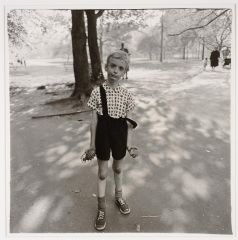
|
Arbus - Child with a Toy Hand Grenade, Central Park - 1962
- subject given opportunity to be strange - suspension of objectivity + subject's own weirdness - dual existence of ugliness & beauty - don't know if on purpose/posed or actually think like that - took away innocence of childhood |
|

|
Aaron Siskind - Chicago - 1957
- like minstrel posters, more abstract b/c don't get solid brick foundation, just tattered wall - like Strand's abstractions - about modernist ambitions of photography - using straight vocab to look around world & extract detail of surface using actual art media as something abstract - subject matter unimportant - about visual effect - human marks |
|
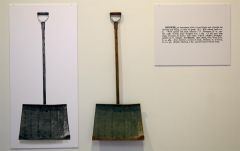
|
Joseph Kosuth - One and Three Shovels - 1965
- picture of shovel, actual shovel, and definition of shovel - no direct correlation between word "shovel" and the meanings we give it - part of linguistics movement in mid60s- early 70s - objective but arbitrary - like Rosler's indexicality |
|
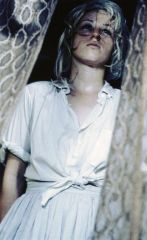
|
Cindy Sherman - Untitled - 1987
- bringing private into public (family business) - domestic violence - cinematic construction - feels real |
|
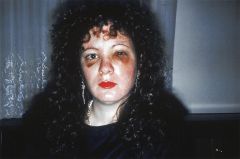
|
Nan Goldin - The Ballad of Sexual Dependency - 1986
- psychological tensions in intimate relationships - snapshot - self-presentation (showing own victimization) - new form of sexual freedom comes out of photo at this time |
|
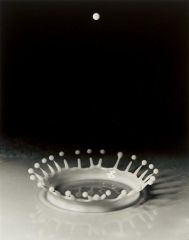
|
Harold Edgerton - Milk Drop Coronet - 1936
- strobe photography - controlling light - picturing the unpicturable (giving new vision via the camera - exploiting its abilities) |
|
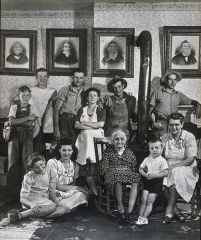
|
Edward Steichen - Family of Man Exhibition - 1955
- understand who is who (roles & relations) because of composition & relates to us as white heteronormative family - humanity shares all kind of experiences (boiled experience down to general experience by featuring diff families) |
|

|
Edward Steichen - Family of Man Exhibition - 1955
- harder to find who is who because its exotic to us - featured in exhibition -> takes voyeuristic view of exotic and tries to condense this exoticism into western tradition |
|
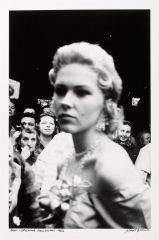
|
Robert Frank - Movie Premier - 1958
In The Americans - focusing not on lady but the (anxious?) reactions of people watching her - double voyeuristic nature (were watching people watching someone) |
|

|
Roy Decarava and Langston Hughes - The Sweet Flypaper of Life - 1955
- photobook (incorporates text + pix) - semi fictional narrative of black culture in Harlem - parallel movement to Family of Man (black family's story from a black perspective) |
|
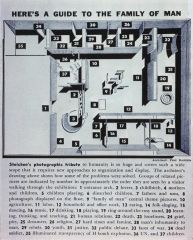
|
Edward Steichen - Family of Man exhibition - 1955
- particular path thru photos (told a story) - argument against nuclear proliferation / war - deals with themes of loss, war, family - humanity shares all kinds of experiences - fragmented / disembodied (hanging pictures, etc interesting layout) |
|

|
Bill Hudson - Walter Gadsden Attacked by Police Dog, Birmingham, AL - 1963
- thinking about art as media - photojournalism was a big part of showing struggle - silk screen a fragment of media landscape -> neutral view/image on serious social issue |
|
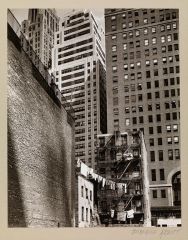
|
Bernice Abbott - Construction: Old and New New York - 1936
- took Atget's approach and applied to US (NYC), straight photography aesthetic - documented change/transition of NYC in 30s to evolve into sight of nostalgia - sublime scale ? |
|
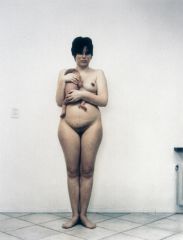
|
Rineke Dijkstra - Saskia, Hardewijk, Netherlands - 1994
- neutral, eye level, straight on portrait of new mothers - clinical, still in hospital (in phase of mother but not yet free to influence child) - shows common starting place of all humanity |
|
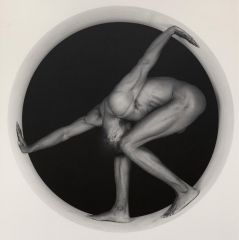
|
Robert Mapplethorpe - Thomas - 1987
- model friend in circle, shows extreme musculature with extreme contrasts - cultural cliche and objectification yet deeply traditional form of art (deep tonalities) yet also deeply conceptual sexuality + objectification - like leonardo da vinci's drawing of perfect man |
|
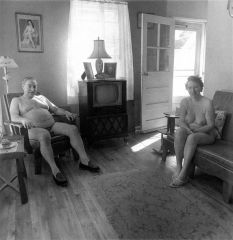
|
Diane Arbus - Retired Man and Wife at Home, New Jersey - 1963
- Arbus took respectful photos in documenting / exposing strangeness - Not judging lifestyles, posing in representative ways about them - Dual existence of ugliness&beauty - ART |
|
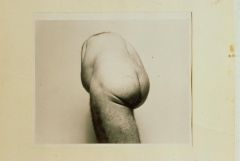
|
John Coplans - A Self-Portrait - 1987
- self portrait, but never shows face - manhood & like Weston did with female body, uses camera to transform (objectify body) - not even neutrally beautiful, just shows what it is and a phallic play of a thing |
|
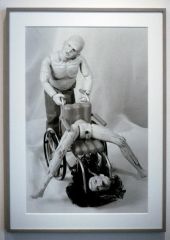
|
Sherman - Untitled - 1999
- postmodern artifice - sexual freedom - barbie dolls melted and broken |
|

|
Larry Clark - Tulsa - 1971
- beginning of sexual freedom in photography, combining sex, drugs rock & roll aesthetic - tulsa = photobook - authenticity validated as participant in the action - meant to be shocking |
|
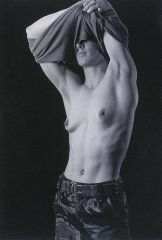
|
Del Lagrace Volcano - Jack Unveiled - 1994
- deliberately gender confusing - part of trans community - response to Maplethorpes photography (black peepee) |

